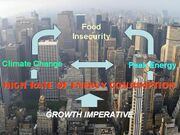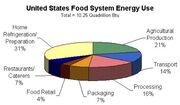Food is directly related to both the issues of energy demand and climate change.

Most produce that reaches your grocer's shelves has traveled some 2,500 kilometres, according to the Leopold Center for Sustainable Agriculture's Food Facts. For multiple ingredient foods such as yogurt, that distance was 3,700 kilometers.
"According to research done on food miles, in 2001, the average weighted average source distance (WASD) for locally grown produce to reach institutional markets was 65 miles, while the conventional WASD for the produce to reach those same institutional points of sale was 1,494 miles, nearly 27 times further. Conventional produce items traveled from eight (pumpkins) to 92 (broccoli) times farther than the local produce to reach points of sale"[1].
Another study conducted in the Waterloo Region of Southwestern Ontario investigated the food miles associated with 58 commonly eaten, imported foods. The study found that each food item traveled an average of 4,497 kilometers or 2,811 miles, producing 51,709 tons of greenhouse gas emissions annually [2].
The whole production of food has been industrialized with farmers purchasing inputs from a number of non-farming industries most of whom are wholly dependent on oil-based products. Seeds, fertilizers, pesticides, farm equipment, food distribution, animal feed are all procured off the farm. Previously these same inputs were derived from outputs from the farm itself. What was once the most sustainable of all industries, has become entirely dependent upon global markets in other industries.

Source: Heller and Keoleian. Life Cycle-Based Sustainability Indicators for Assessment of the U.S. Food System. 2000
According to Center for Sustainable Systems at the University of Michigan, the food system consumes 10% of the US consumption of energy, roughly 100 Quadtillion BTUs annually.
A Japanese study found that eating locally grown produce can reduce energy consumption by the equivalent of a reduction of household energy use by 20% [3].
Today our food system accounts for approximately 20% to the national energy demand and produces more green house gases and contributes more to climate change than any other industry, in the range of 17-34% depending on the study (Michael Pollan, Deep Agriculture, 2009).
Last century agriculture produced 2 calories of food energy for every calorie of energy used to grow and distribute it. Today our industrial oil-based food system takes 10 calories of energy to produce one calorie of food energy. That steak we enjoy on the barbeque takes 55 calories to create and delivery it to our table for each calorie it provides.
In terms of health, four of the top ten killers are chronic diseases linked to diet; 2/3 of heart disease can be linked to diet; 40% of cancer is linked to diet; most of obesity and type-II diabetes is caused by diet; the CDC estimates that ¾ of the healthcare expenses in the US goes to treat preventable chronic diseases linked to diet.
Our food system is broken. Cheap food has cost us dearly in terms of our health, economic resilience, climatic stability, and may well cost us social stability if the experts on peak oil are only moderately correct.
As most people can attest to, food prices have risen dramatically in the last year -- risen and stayed high despite the subsequent crash of oil prices late in 2008. Quite simply, the demand for food has steadily increased, while the costs of producing food have increased as well as the supply of food (due to environmental conditions, like the drought in Australia for instance) is decreasing [4]. Between the start of 2006 and 2008, the average world price for rice rose by 217%, wheat by 136%, maize by 125% and soybeans by 107% [5]. In late April 2008, rice prices hit 24 cents a pound, twice the price that it was seven months earlier [6]. thumb|300px|leftAs an alternative the Made in Alberta initiative is helping to reduce GHGs and transportation costs, while improving food quality. They document how local growers and food retailers have got together to provide consumers with local produce.
Similarly, Ottawa's Just Food is connecting local food suppliers and consumers to provide the best that the Ottawa Valley can provide. Be sure and check out their Local Food Guide to find the local foods you want.
References[]
1. Checking the food odometer: Comparing food miles for local versus conventional produce sales to Iowa institutions, Leopold Center for Sustainable Agriculture, 2003
2. Xureb, Marc. 2005. Food Miles: Environmental Implication of Food Imports to Waterloo Region. www.leopold.iastate.edu/research/marketing_files/foodmiles_Canada_1105.pdf
3. The Local Solution, Adbusters, March-April 2006
4.. 2007–2008 World Food Price Crisis, Wikipedia,
5. Financial speculators reap profits from global hunger
6. "Cyclone fuels rice price increase", BBC News, May 7, 2008